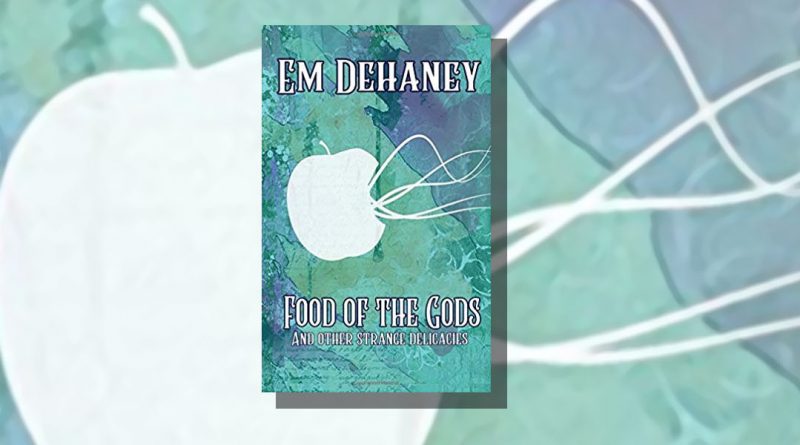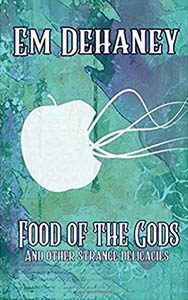Food of the Gods by Em Dehaney
– Reviewed by Rhys Knapman –
Food of the Gods is a single author collection of seven horror stories and a poem written by Em Dehaney and published in February 2018. Despite a link in genre, the stories vary greatly in tense, tone and perspective. All share the elements that are important in telling a good horror story —mystery, suspense and a dash of the supernatural, blended and served.
First is the eponymous ‘Food of the Gods’. The tale opens with the return of Alderney Finch of the House of Finch confectioners from a tasting session in Venezuela. We are told it was upon his return that ‘the dreams began’, and while disturbing, these do not appear to bother Finch. Yet. What matters to him is his shop, which is suggested to be—if not failing, then—unable to compete with larger stores. However, he has an idea for a new recipe that is sure to change this.
He begins to create his truffles near enough the moment he walks through the door. During this time, he cuts off the top of his index finger.
The cartoonish fountain of blood that follows this accident is somewhat ill-fitting in what is otherwise a dark and realistic horror story: the spray is described as practically repainting the room and falling into his truffle pile.
“And worst of all, there was a fine blood spatter decorating the tray of lime and basil bonbons he scoffed down in the dark last night.
But they were delicious.”
After a brief trip to A and E (cut short because he forgot the digit) he eats a truffle and decides to serve them to his customers. Rather than getting closed down for violating all the food safety codes, he rockets to success and opens a chain.
During this section, every element of each sensation involved in eating the truffle is described in beautiful detail. Later, flavours and sensations are less complete, hinting at the way the blood-truffles have caused a Flowers for Algernon style reaction in Finch. He has become accustomed to the flavours of the blood-truffles and now cannot cope with less exotic ingredients.
All the while, his dreams get more intense and begin to seep into the real world.
Overall, ‘Food of the Gods’ is a delightful read filled with beautiful imagery and featuring a compelling protagonist. This culminates in a twist ending that, while not obvious from the beginning, does not veer out of nowhere and does not leave the reader feeling unsatisfied with the journey. It is remarkable that so much was done in so few words (under 3000).
Following this is the short story ‘Bellarmine’. While not explicitly stated, it can be gathered that this tale takes place during the witch hunting craze in the mid 1600s. Evidence includes the initial premise, of the creation of a Bellarmine jar in order to counter a ‘hex’, and the lowly living situation of the second protagonist, Elizabeth, who dreams to one day be the ‘lady of her own manor’.
‘Bellarmine’ is a story spit in two uneven parts. For the first part we follow Nathaniel, being given an uncomfortably personal account of all of the steps required to create a counter-hex, information about his life and why he believes his wife, Elizabeth, may be a witch. Then, we follow Elizabeth. She, naturally, is terrified.
Once again, the ending is hinted at throughout but never blatantly. The story is more heavily focused on characters than plot and the horror comes from Nathaniel’s psychological state and what he has put Elizabeth through as much anything that actually happens to either of them.
Possibly the strongest example of horror fiction in the collection comes from the tale ‘The Mermaid’s Purse’. Like ‘Bellarmine’, ‘The Mermaid’s Purse’ focuses more on the relationships of the characters than on plot in delivering a compelling story. However, unlike ‘Bellarmine’, the close third person narration is unreliable, a standard for stories told from the point of view of children.
We follow Mikey, a child on holiday at the beach. He and his mother seem conflicted on what they want to do — the bar for her, the rock pool for him — and decide to split up. It is then that Mikey finds a mermaid’s purse, a shark egg pouch, and immediately ditches his other finds. The story then follows Mikey as he transports the egg back home in a Tupperware box and his subsequent quest to find suitable places to store the rapidly growing shark. Along the way, we discover the extent of the abusive relationship shared by Mikey and his mother.
The shark acts well as a metaphor for Mikey’s growing aggressive streak even before the twist at the end. Again, the twist is not so outlandish that it cannot be predicted, and the clues are based more in reality than other stories in the collection. Overall, this short story is a great example of how horror can be drawn from psychological sources — the introduction of something unusual into a protagonist’s ordinary life — as well as in-your-face graphic content.
As is so often the case in the genre, brief descriptions barely scratch the surface of what can be found both on and off the page. There are subtle and overt references to the works of Lovecraft and Stoker (amongst others), and the imagery is expertly crafted to put you in the same boat as the protagonists. Fans of the horror genre will certainly enjoy these stories.



